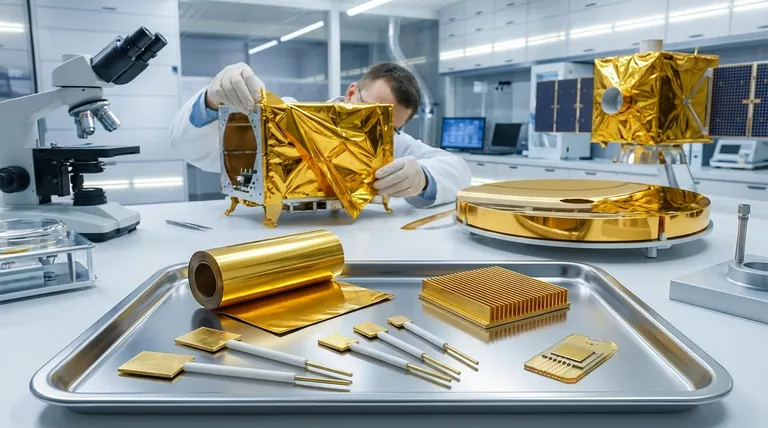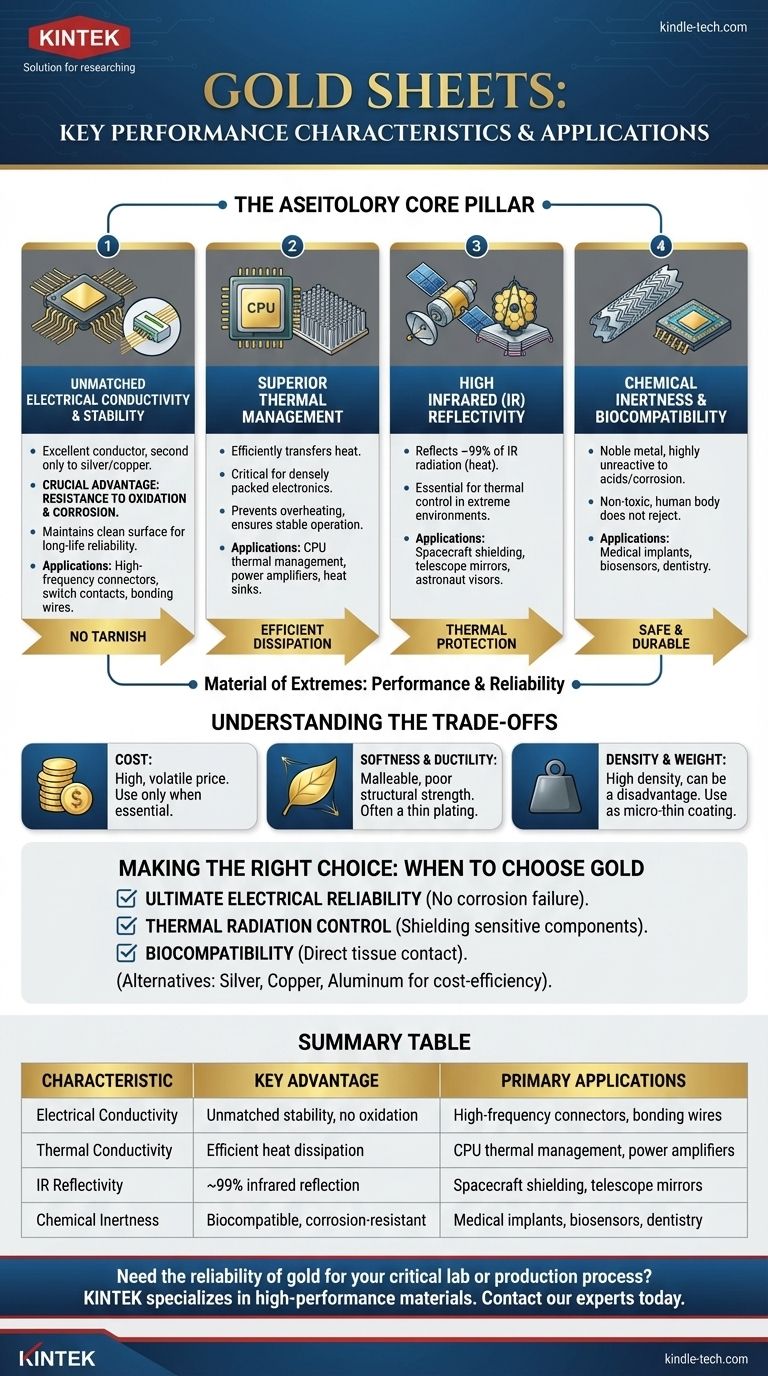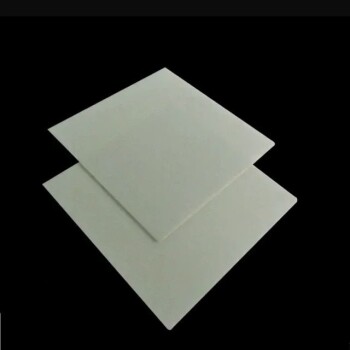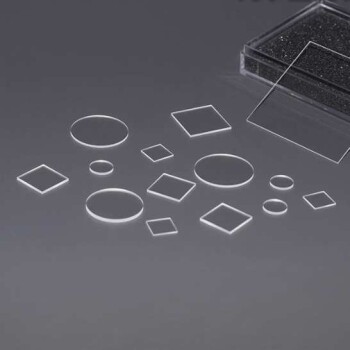At its core, a gold sheet is a material of extremes, chosen when performance and reliability cannot be compromised. Its primary characteristics are exceptionally high electrical and thermal conductivity, superior reflectivity of infrared radiation, and remarkable chemical inertness. These properties make it indispensable in demanding electronics, aerospace, and medical applications.
While often considered for its conductivity, gold's true value lies in its stability. It performs its function consistently over long periods in harsh environments because it does not tarnish or corrode, a failure point for many other conductive metals.

The Core Performance Pillars of Gold
To understand where gold sheets excel, we must analyze their fundamental physical properties. Each characteristic enables a distinct set of high-value applications.
Unmatched Electrical Conductivity and Stability
Gold is one of the best electrical conductors, second only to silver and copper. However, its crucial advantage is its resistance to oxidation and corrosion.
Where materials like copper and silver form insulating oxide layers that degrade signal integrity over time, gold maintains a clean, reliable surface. This makes it the definitive choice for long-life, high-reliability electronic components.
Common applications include high-frequency connectors, switch contacts, and the microscopic bonding wires that connect a silicon chip to its package.
Superior Thermal Management
Gold is also an excellent thermal conductor, efficiently transferring heat away from a source. This property is critical in densely packed electronics where heat dissipation is a primary concern.
By plating or bonding gold foil to components like CPUs or power amplifiers, engineers can create an effective pathway to move thermal energy to a heat sink, preventing overheating and ensuring stable operation.
High Infrared (IR) Reflectivity
Gold is highly effective at reflecting electromagnetic radiation, particularly in the infrared spectrum (heat). Approximately 99% of infrared radiation that hits a gold surface is reflected.
This property is leveraged for thermal control. In space applications, gold foil shields satellites and sensitive instruments from the intense heat of the sun. The iconic gold-coated visors on astronaut helmets serve the same purpose, protecting them from solar radiation.
Perhaps the most famous example is the gold coating on the mirrors of the James Webb Space Telescope, which is optimized to reflect infrared light from distant galaxies.
Chemical Inertness and Biocompatibility
Gold is a noble metal, meaning it is extremely unreactive and resistant to degradation from most acids and corrosive environments.
This chemical stability, combined with its non-toxic nature, makes it highly biocompatible. The human body does not reject it, which is why it has a long history of use in dentistry and, more recently, in medical implants and biosensors.
Understanding the Trade-offs
Choosing gold is a decision driven by requirements, but it is not without significant trade-offs that must be carefully considered.
The Obvious Factor: Cost
The most significant barrier to using gold is its high and often volatile price. Its use is almost exclusively limited to applications where its unique properties are absolutely essential and no cheaper alternative can meet the performance or reliability requirements.
Mechanical Properties: Softness and Ductility
Gold is extremely malleable and ductile, meaning it can be hammered into incredibly thin sheets (gold leaf) or drawn into fine wires. While this is an advantage for manufacturing thin films and coatings, it also means gold is very soft.
As a bulk material, it has poor structural strength and is easily scratched or damaged. This is why gold is almost always applied as a thin plating or foil onto a stronger substrate material.
Density and Weight
Gold is one of the densest metals. This high density can be a significant disadvantage in weight-sensitive applications like aerospace or portable devices.
This further reinforces its use as a micro-thin coating rather than a structural component, providing the desired surface properties without adding prohibitive mass.
Making the Right Choice for Your Goal
Selecting gold is a strategic engineering decision. Use the following guidelines to determine if it aligns with your project's primary objective.
- If your primary focus is ultimate electrical reliability: Gold's resistance to corrosion makes it the only choice for critical connectors and contacts that must perform flawlessly for years.
- If your primary focus is thermal radiation control: Gold's unmatched infrared reflectivity is essential for shielding sensitive components from heat, especially in vacuum or space environments.
- If your primary focus is biocompatibility: Gold's inertness is a non-negotiable requirement for medical implants or sensors that will be in direct contact with biological tissue.
- If your primary focus is cost-efficiency: You should almost always explore alternatives like silver, copper, or aluminum, which provide good performance for most standard applications.
Choosing gold is an investment in certainty for applications where failure is not an option.
Summary Table:
| Characteristic | Key Advantage | Primary Applications |
|---|---|---|
| Electrical Conductivity | Unmatched stability, no oxidation | High-frequency connectors, bonding wires |
| Thermal Conductivity | Efficient heat dissipation | CPU thermal management, power amplifiers |
| IR Reflectivity | ~99% infrared reflection | Spacecraft shielding, telescope mirrors |
| Chemical Inertness | Biocompatible, corrosion-resistant | Medical implants, biosensors, dentistry |
Need the reliability of gold for your critical lab or production process? KINTEK specializes in high-performance lab equipment and consumables, including materials for demanding applications. Our expertise ensures you get the right solutions for superior conductivity, thermal management, and biocompatibility. Contact our experts today to discuss how we can support your laboratory's specific needs with precision and reliability.
Visual Guide

Related Products
- Gold Electrochemical Sheet Electrode Gold Electrode
- Platinum Sheet Electrode for Laboratory and Industrial Applications
- High-Purity Titanium Foil and Sheet for Industrial Applications
- Silicon Carbide (SIC) Ceramic Sheet Wear-Resistant Engineering Advanced Fine Ceramics
- High Purity Zinc Foil for Battery Lab Applications
People Also Ask
- What is a common application for a gold plate electrode in electrochemistry? The Key to Reliable and Accurate Measurements
- How should a gold plate electrode be handled during an experiment? Ensure Accurate and Reproducible Results
- What is the operating principle of a gold disc electrode in an electrochemical system? Unlock Precision with a Stable Interface
- What precautions should be taken to prevent mechanical damage to a gold plate electrode? Protect Your Data Integrity
- What are the performance characteristics of a gold plate electrode? Unmatched Stability for Reliable Data








